Wei-Shi Zheng
Hierarchical Vision-Language Learning for Medical Out-of-Distribution Detection
Aug 25, 2025


Abstract:In trustworthy medical diagnosis systems, integrating out-of-distribution (OOD) detection aims to identify unknown diseases in samples, thereby mitigating the risk of misdiagnosis. In this study, we propose a novel OOD detection framework based on vision-language models (VLMs), which integrates hierarchical visual information to cope with challenging unknown diseases that resemble known diseases. Specifically, a cross-scale visual fusion strategy is proposed to couple visual embeddings from multiple scales. This enriches the detailed representation of medical images and thus improves the discrimination of unknown diseases. Moreover, a cross-scale hard pseudo-OOD sample generation strategy is proposed to benefit OOD detection maximally. Experimental evaluations on three public medical datasets support that the proposed framework achieves superior OOD detection performance compared to existing methods. The source code is available at https://openi.pcl.ac.cn/OpenMedIA/HVL.
CoopDiff: Anticipating 3D Human-object Interactions via Contact-consistent Decoupled Diffusion
Aug 10, 2025Abstract:3D human-object interaction (HOI) anticipation aims to predict the future motion of humans and their manipulated objects, conditioned on the historical context. Generally, the articulated humans and rigid objects exhibit different motion patterns, due to their distinct intrinsic physical properties. However, this distinction is ignored by most of the existing works, which intend to capture the dynamics of both humans and objects within a single prediction model. In this work, we propose a novel contact-consistent decoupled diffusion framework CoopDiff, which employs two distinct branches to decouple human and object motion modeling, with the human-object contact points as shared anchors to bridge the motion generation across branches. The human dynamics branch is aimed to predict highly structured human motion, while the object dynamics branch focuses on the object motion with rigid translations and rotations. These two branches are bridged by a series of shared contact points with consistency constraint for coherent human-object motion prediction. To further enhance human-object consistency and prediction reliability, we propose a human-driven interaction module to guide object motion modeling. Extensive experiments on the BEHAVE and Human-object Interaction datasets demonstrate that our CoopDiff outperforms state-of-the-art methods.
TypeTele: Releasing Dexterity in Teleoperation by Dexterous Manipulation Types
Jul 02, 2025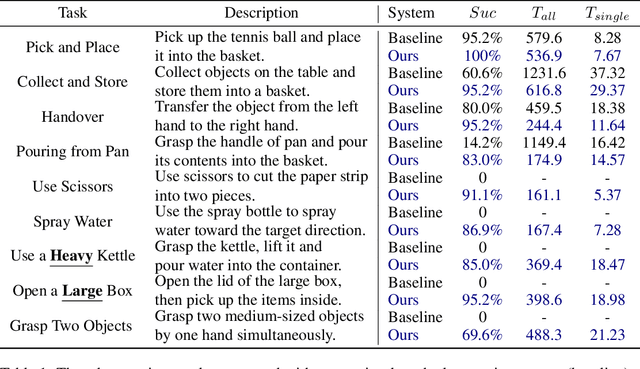


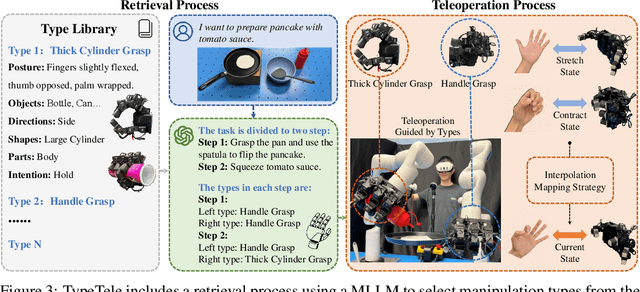
Abstract:Dexterous teleoperation plays a crucial role in robotic manipulation for real-world data collection and remote robot control. Previous dexterous teleoperation mostly relies on hand retargeting to closely mimic human hand postures. However, these approaches may fail to fully leverage the inherent dexterity of dexterous hands, which can execute unique actions through their structural advantages compared to human hands. To address this limitation, we propose TypeTele, a type-guided dexterous teleoperation system, which enables dexterous hands to perform actions that are not constrained by human motion patterns. This is achieved by introducing dexterous manipulation types into the teleoperation system, allowing operators to employ appropriate types to complete specific tasks. To support this system, we build an extensible dexterous manipulation type library to cover comprehensive dexterous postures used in manipulation tasks. During teleoperation, we employ a MLLM (Multi-modality Large Language Model)-assisted type retrieval module to identify the most suitable manipulation type based on the specific task and operator commands. Extensive experiments of real-world teleoperation and imitation learning demonstrate that the incorporation of manipulation types significantly takes full advantage of the dexterous robot's ability to perform diverse and complex tasks with higher success rates.
Chain of Methodologies: Scaling Test Time Computation without Training
Jun 08, 2025Abstract:Large Language Models (LLMs) often struggle with complex reasoning tasks due to insufficient in-depth insights in their training data, which are typically absent in publicly available documents. This paper introduces the Chain of Methodologies (CoM), an innovative and intuitive prompting framework that enhances structured thinking by integrating human methodological insights, enabling LLMs to tackle complex tasks with extended reasoning. CoM leverages the metacognitive abilities of advanced LLMs, activating systematic reasoning throught user-defined methodologies without explicit fine-tuning. Experiments show that CoM surpasses competitive baselines, demonstrating the potential of training-free prompting methods as robust solutions for complex reasoning tasks and bridging the gap toward human-level reasoning through human-like methodological insights.
Reinforcing Video Reasoning with Focused Thinking
May 30, 2025Abstract:Recent advancements in reinforcement learning, particularly through Group Relative Policy Optimization (GRPO), have significantly improved multimodal large language models for complex reasoning tasks. However, two critical limitations persist: 1) they often produce unfocused, verbose reasoning chains that obscure salient spatiotemporal cues and 2) binary rewarding fails to account for partially correct answers, resulting in high reward variance and inefficient learning. In this paper, we propose TW-GRPO, a novel framework that enhances visual reasoning with focused thinking and dense reward granularity. Specifically, we employs a token weighting mechanism that prioritizes tokens with high informational density (estimated by intra-group variance), suppressing redundant tokens like generic reasoning prefixes. Furthermore, we reformulate RL training by shifting from single-choice to multi-choice QA tasks, where soft rewards enable finer-grained gradient estimation by distinguishing partial correctness. Additionally, we propose question-answer inversion, a data augmentation strategy to generate diverse multi-choice samples from existing benchmarks. Experiments demonstrate state-of-the-art performance on several video reasoning and general understanding benchmarks. Notably, TW-GRPO achieves 50.4\% accuracy on CLEVRER (18.8\% improvement over Video-R1) and 65.8\% on MMVU. Our codes are available at \href{https://github.com/longmalongma/TW-GRPO}{https://github.com/longmalongma/TW-GRPO}.
Long-RVOS: A Comprehensive Benchmark for Long-term Referring Video Object Segmentation
May 19, 2025Abstract:Referring video object segmentation (RVOS) aims to identify, track and segment the objects in a video based on language descriptions, which has received great attention in recent years. However, existing datasets remain focus on short video clips within several seconds, with salient objects visible in most frames. To advance the task towards more practical scenarios, we introduce \textbf{Long-RVOS}, a large-scale benchmark for long-term referring video object segmentation. Long-RVOS contains 2,000+ videos of an average duration exceeding 60 seconds, covering a variety of objects that undergo occlusion, disappearance-reappearance and shot changing. The objects are manually annotated with three different types of descriptions to individually evaluate the understanding of static attributes, motion patterns and spatiotemporal relationships. Moreover, unlike previous benchmarks that rely solely on the per-frame spatial evaluation, we introduce two new metrics to assess the temporal and spatiotemporal consistency. We benchmark 6 state-of-the-art methods on Long-RVOS. The results show that current approaches struggle severely with the long-video challenges. To address this, we further propose ReferMo, a promising baseline method that integrates motion information to expand the temporal receptive field, and employs a local-to-global architecture to capture both short-term dynamics and long-term dependencies. Despite simplicity, ReferMo achieves significant improvements over current methods in long-term scenarios. We hope that Long-RVOS and our baseline can drive future RVOS research towards tackling more realistic and long-form videos.
ActionArt: Advancing Multimodal Large Models for Fine-Grained Human-Centric Video Understanding
Apr 25, 2025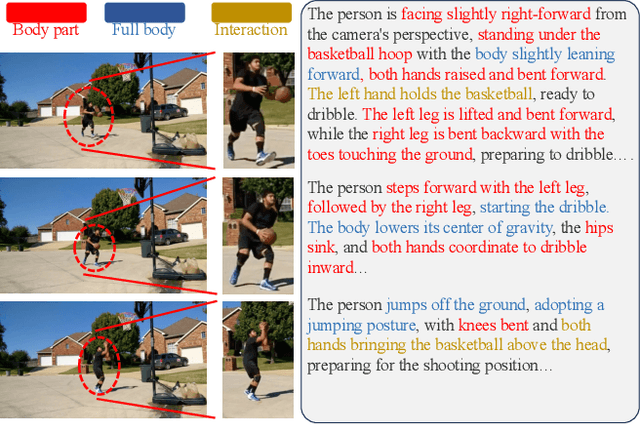
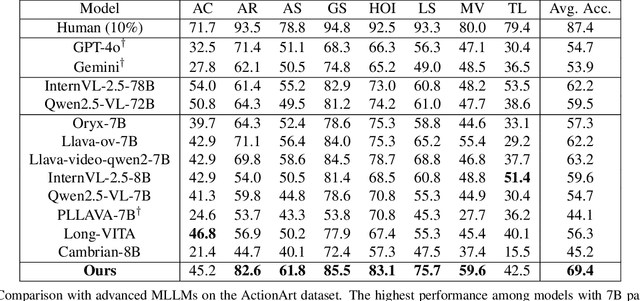

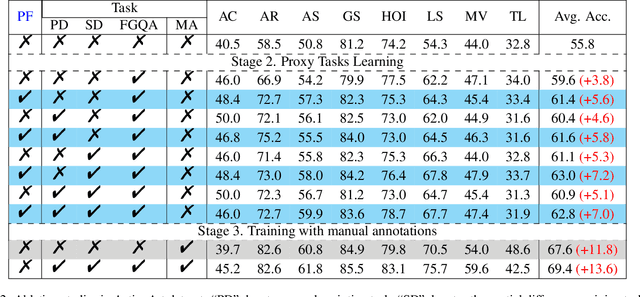
Abstract:Fine-grained understanding of human actions and poses in videos is essential for human-centric AI applications. In this work, we introduce ActionArt, a fine-grained video-caption dataset designed to advance research in human-centric multimodal understanding. Our dataset comprises thousands of videos capturing a broad spectrum of human actions, human-object interactions, and diverse scenarios, each accompanied by detailed annotations that meticulously label every limb movement. We develop eight sub-tasks to evaluate the fine-grained understanding capabilities of existing large multimodal models across different dimensions. Experimental results indicate that, while current large multimodal models perform commendably on various tasks, they often fall short in achieving fine-grained understanding. We attribute this limitation to the scarcity of meticulously annotated data, which is both costly and difficult to scale manually. Since manual annotations are costly and hard to scale, we propose proxy tasks to enhance the model perception ability in both spatial and temporal dimensions. These proxy tasks are carefully crafted to be driven by data automatically generated from existing MLLMs, thereby reducing the reliance on costly manual labels. Experimental results show that the proposed proxy tasks significantly narrow the gap toward the performance achieved with manually annotated fine-grained data.
PVUW 2025 Challenge Report: Advances in Pixel-level Understanding of Complex Videos in the Wild
Apr 15, 2025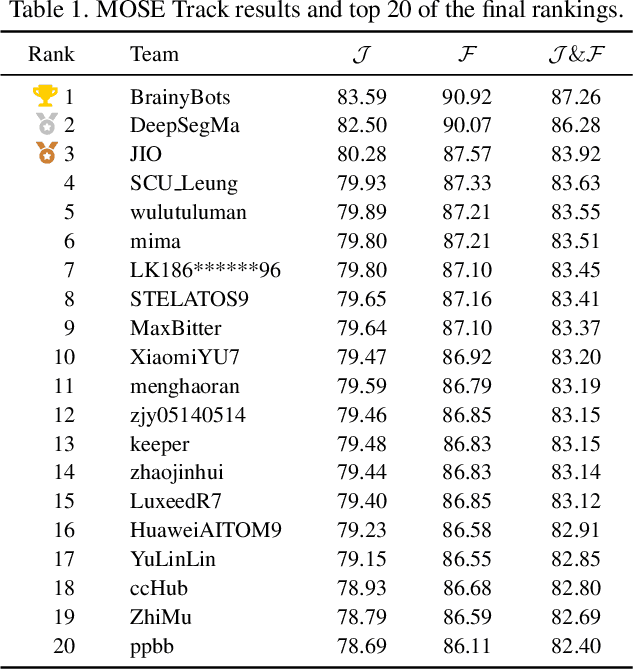
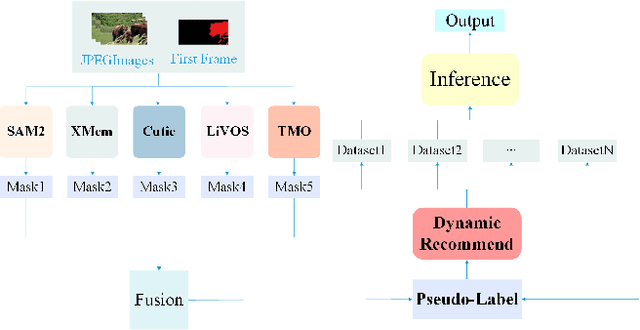
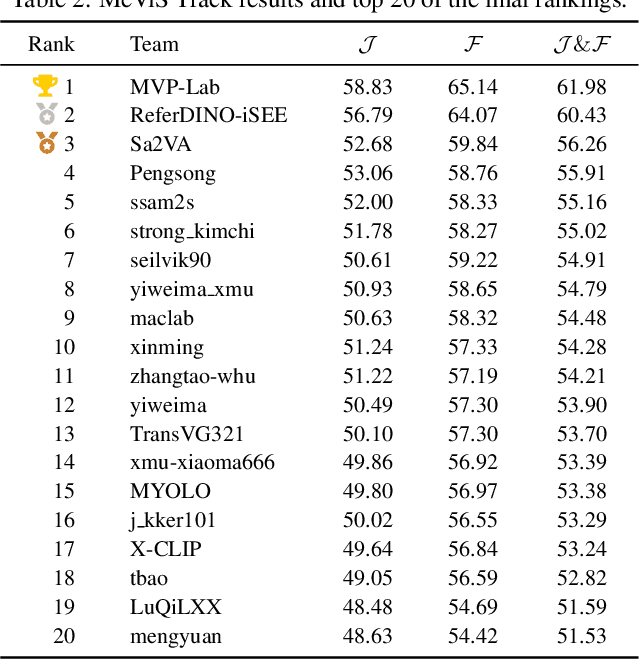
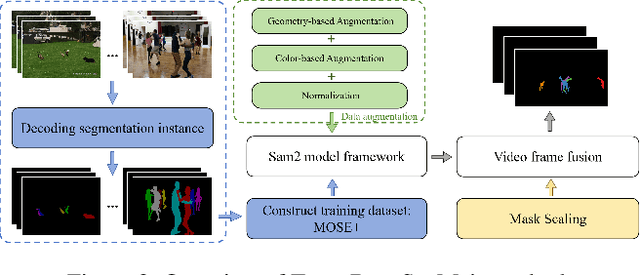
Abstract:This report provides a comprehensive overview of the 4th Pixel-level Video Understanding in the Wild (PVUW) Challenge, held in conjunction with CVPR 2025. It summarizes the challenge outcomes, participating methodologies, and future research directions. The challenge features two tracks: MOSE, which focuses on complex scene video object segmentation, and MeViS, which targets motion-guided, language-based video segmentation. Both tracks introduce new, more challenging datasets designed to better reflect real-world scenarios. Through detailed evaluation and analysis, the challenge offers valuable insights into the current state-of-the-art and emerging trends in complex video segmentation. More information can be found on the workshop website: https://pvuw.github.io/.
Modeling Multiple Normal Action Representations for Error Detection in Procedural Tasks
Apr 02, 2025



Abstract:Error detection in procedural activities is essential for consistent and correct outcomes in AR-assisted and robotic systems. Existing methods often focus on temporal ordering errors or rely on static prototypes to represent normal actions. However, these approaches typically overlook the common scenario where multiple, distinct actions are valid following a given sequence of executed actions. This leads to two issues: (1) the model cannot effectively detect errors using static prototypes when the inference environment or action execution distribution differs from training; and (2) the model may also use the wrong prototypes to detect errors if the ongoing action label is not the same as the predicted one. To address this problem, we propose an Adaptive Multiple Normal Action Representation (AMNAR) framework. AMNAR predicts all valid next actions and reconstructs their corresponding normal action representations, which are compared against the ongoing action to detect errors. Extensive experiments demonstrate that AMNAR achieves state-of-the-art performance, highlighting the effectiveness of AMNAR and the importance of modeling multiple valid next actions in error detection. The code is available at https://github.com/iSEE-Laboratory/AMNAR.
Decoupled Distillation to Erase: A General Unlearning Method for Any Class-centric Tasks
Mar 31, 2025Abstract:In this work, we present DEcoupLEd Distillation To Erase (DELETE), a general and strong unlearning method for any class-centric tasks. To derive this, we first propose a theoretical framework to analyze the general form of unlearning loss and decompose it into forgetting and retention terms. Through the theoretical framework, we point out that a class of previous methods could be mainly formulated as a loss that implicitly optimizes the forgetting term while lacking supervision for the retention term, disturbing the distribution of pre-trained model and struggling to adequately preserve knowledge of the remaining classes. To address it, we refine the retention term using "dark knowledge" and propose a mask distillation unlearning method. By applying a mask to separate forgetting logits from retention logits, our approach optimizes both the forgetting and refined retention components simultaneously, retaining knowledge of the remaining classes while ensuring thorough forgetting of the target class. Without access to the remaining data or intervention (i.e., used in some works), we achieve state-of-the-art performance across various benchmarks. What's more, DELETE is a general solution that can be applied to various downstream tasks, including face recognition, backdoor defense, and semantic segmentation with great performance.
 Add to Chrome
Add to Chrome Add to Firefox
Add to Firefox Add to Edge
Add to Edge